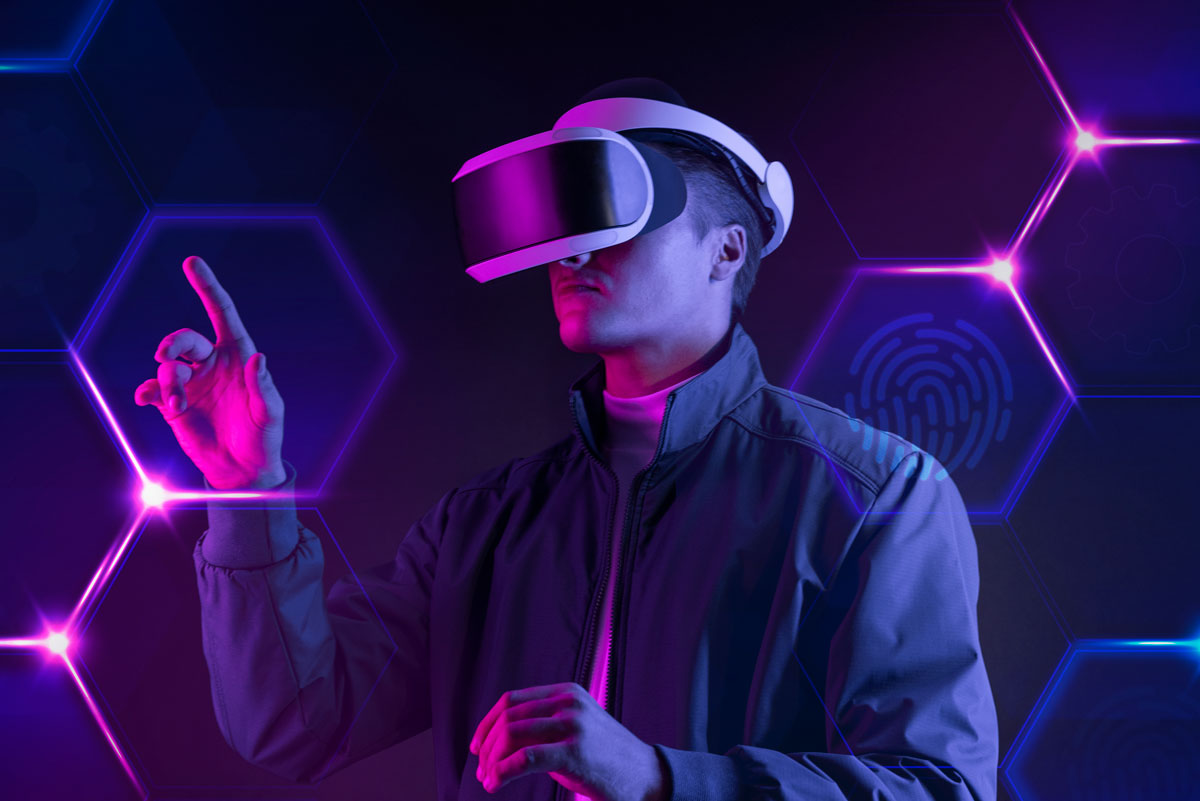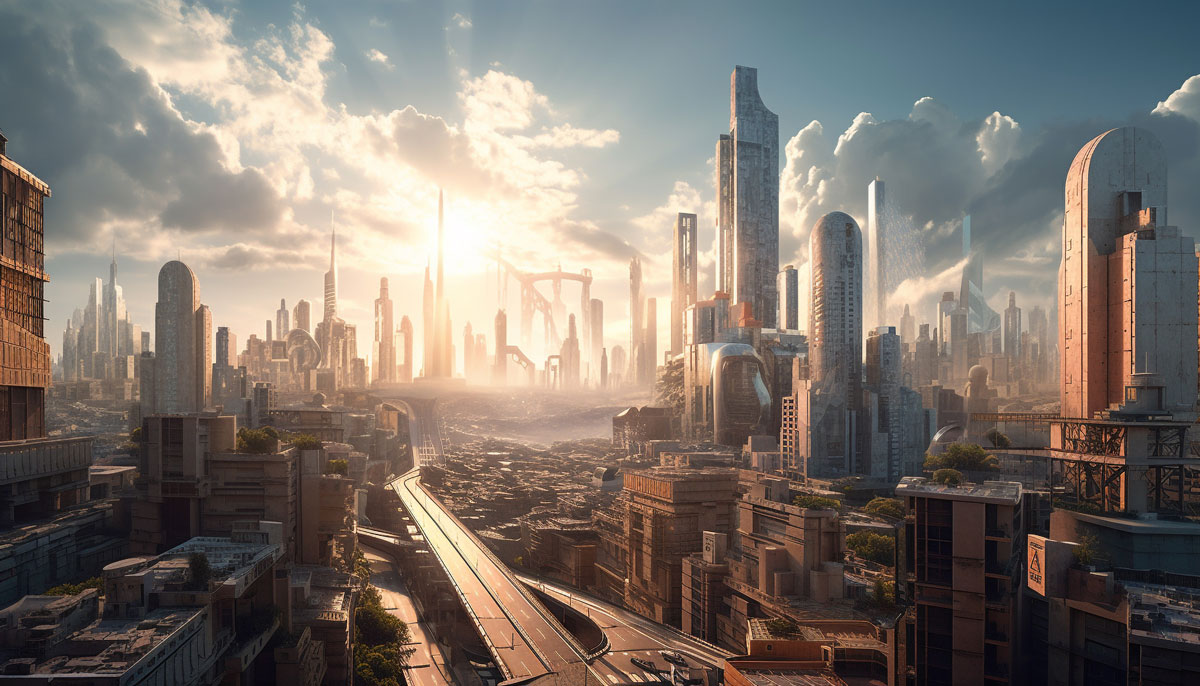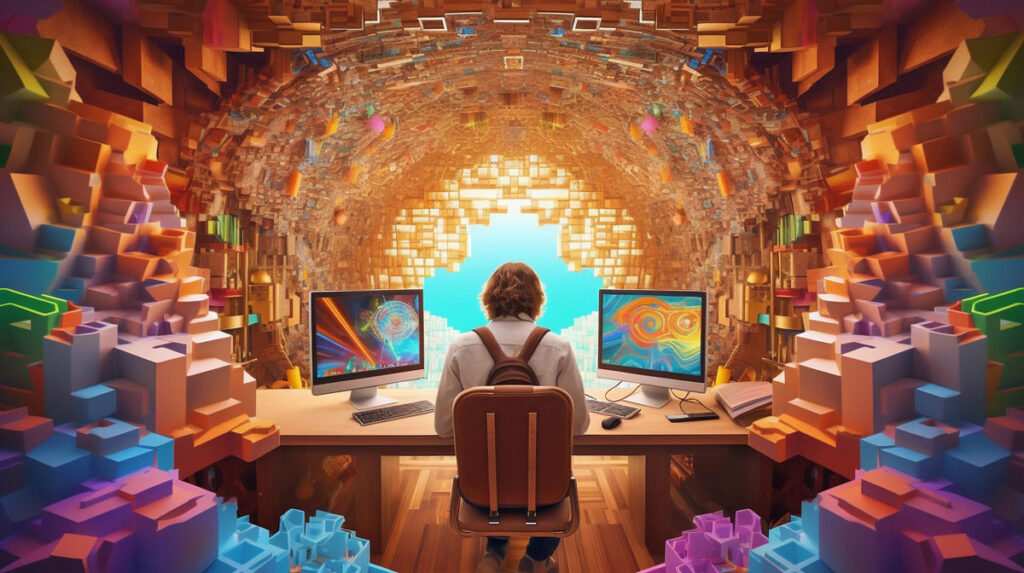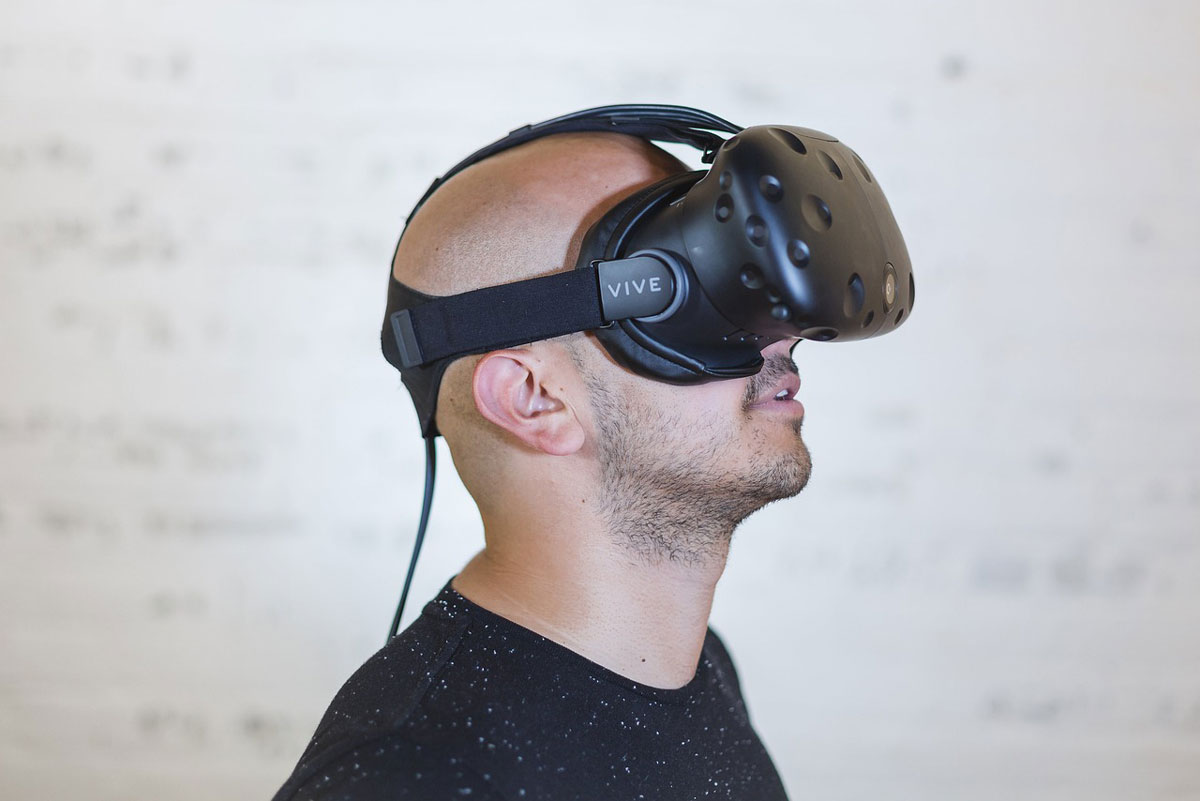Updated by Nazanin Ghodsian, 10/01/2024
The Metaverse has become a phenomena that is transforming society and capturing the interest of both tech enthusiasts and trailblazers. Presently, about 400 million people engage in the Metaverse, encountering genuinely distinct and ever-changing settings. As to the latest estimations, the Metaverse’s economic worth is anticipated to reach $1.5 trillion by 2030, an amount that surpasses previous estimates of the global cryptocurrency market by almost 300 times.
Unquestionably, the significance of Architecture in the Metaverse is undeniable because it helps to create amazing, dynamic, and immersive spatial experiences that help to realize the Metaverse’s promise. But might this quickly evolving virtual reality become the new frontier for architects?
This paper explores the central function of Architecture in the Metaverse while diving into the core ideas and unique characteristics of the virtual environment. We will also look at the particular potential and difficulties that architects have in this digital space, showcasing some creative architectural projects that take place in the Metaverse. Architecture has a unique opportunity to influence the direction of virtual surroundings as this digital frontier develops, providing fresh opportunities for innovation and design.
Table of Contents
What is the Metaverse?
Hardly a day passes without hearing the words “metaverse,” “augmented reality,” “virtual reality,” and “NFT” (non-fungible token) in our everyday conversation, news commentary, or social media feed. The technological metaverse has become especially popular since “Meta” was introduced by Mark Zuckerberg, Facebook founder.
If you are a fan of the TV series Black Mirror, you have probably already met a fictional reality. But the concept and function of the Metaverse have completely surpassed our previous notions of fictional reality. Because the evolution of the world and technological development have caused huge changes in the concept and structure of this fictional reality. Today, there is no clear limit to design, creativity and innovation freedom in the Metaverse.
Definition of the Metaverse
The word “Metaverse” is a combination of two words “Meta” meaning beyond and “Universe” meaning world. Metaverse is a pervasive online virtual world being developed as the next phase of the Internet. Metaverse technology is the platform and foundation of a three-dimensional collective space for all-round interaction between people and virtual objects.

In other words, the Metaverse is a hyperreal digital realm of permanent, three-dimensional, and online virtual environments. An environment accessible by personal computers, smart devices, virtual reality and augmented reality hardware. It is no exaggeration to claim that the Metaverse is one of the undisputed heroes of the last few years. It has transformed video games and technology.
Metaverse is not an original concept, but recent technological developments have provided the necessary platform for its wide application and touching experiences. For this reason, Metaverse’s popularity depends on technological advances in other fields. This includes the development of the Internet and the creation of innovative tools in recent decades. This digital world includes augmented reality, virtual reality, 3D holographic avatars, video and other forms of communication for better interaction between people. We will examine some of these cases in the following.
Exclusive Metaverse user avatars
This developing concept has attracted many people’s attention. In addition to being eager to utilize this digital platform, they are always enthusiastic about emerging technologies. User interaction in the Metaverse is done through virtual presence and living in a digital realm. This is done by using avatars and integrating virtual reality, augmented reality and similar technologies. Metaverse’s unique digital avatars provide users with a parallel life.
Seamless Connection to Different Metaverse Platforms
With the connection of several virtual environments, users can interact, attend various events, trade, and gain special experiences through integrating diverse metaverses. Finally, by connecting to this digital realm, the opportunity to gain experience through expanding the senses of sight, hearing and touch and immersing themselves in 3D environments becomes possible.
The Main Roles in the Metaverse
Undoubtedly, this upcoming world will not develop at once without providing the required infrastructure and experts in various fields. So far, experts in various scientific fields have been promising and encouraging the development of a universal platform for users. The formation and construction of spaces, the design of different experiences affecting human feelings and emotions, earning money for land owners in the metaverse, etc., depend only on the integration of different principles through the participation and activity of several scientific fields in the metaverse. In the following, we will introduce the experts who create the basic cornerstone for building the Metaverse. They play a fundamental role in the development of this platform.
Real Estate Developers
Metaverse created an innovative and profitable economic platform for real estate developers. Because on this platform, land is considered a valuable asset and can be bought and sold through NFT (non-fungible tokens). Metaverse ownership transfer is different from traditional real estate buying and selling.
Buying land on a virtual platform is a smart way to invest and has incredible development prospects. Any real estate developer can get a few steps ahead of their business counterparts by investing faster in acquiring land. Alternatively, with famous brands such as Nike, Adidas, etc., buying a piece of land in the Metaverse, the real estate economy will grow exponentially. The demand for land with special and customized designs also adds to the importance of Architecture in the Metaverse.
Architects
Profitability and earning money through land depend on creating a different spatial experience and providing new service models in the Metaverse. In other words, earning money on empty land without spatial planning is far-fetched; because Metaverse users only pay for the different feelings and experiences that this virtual platform brings them.

This is where we realize the bold role of architecture in the Metaverse construction and development. Architects, with the necessary expertise in presenting concepts and ideas, play a key role in creating experiences similar to and reflecting the real world in the virtual world. In the rest of this article, we will discuss Architecture in the Metaverse.
Game Designers
Game design is one of the most critical aspects of blockchain games. The designers of this series of games create enjoyable virtual game environments for users. Game design challenges in the Metaverse are more complex. Because game designers must create experiences beyond common games and focus on the appearance and touch of real experiences in the virtual world.
Designers, Artists, and Content Producers
With the advent of non-fungible tokens (NFTs), content creators, artists, and designers can take control and connect directly with investors. The introduction of the Metaverse can lead to other dimensions of content production. Since there are no geographical restrictions in the metaverse, artists, fashion designers, etc., can freely sell their works in the global metaverse.
For example, musicians and singers can earn money directly by holding virtual concerts in Metaverse buildings and receiving NFT tickets. So far, Metaverse has hosted concerts by superstars like Travis Scott and Ariana Grande on Fortnite. Perhaps facilities such as designing several skins and different backgrounds for the concert venue and creating the desired spatial experience for the user are the reasons behind the popularity and unimaginable statistics of Metaverse concerts.
The Role of Architecture in the Metaverse
With the ever-increasing development of Metaverse, the number of users and presence on this virtual platform is gradually increasing. This means that virtual spaces are in demand. Architecture is one of the specialties that contribute to this demand. In addition to many different definitions of the Metaverse, there are different opinions about the role of architecture in the metaverse.

With the evolution and development of the virtual world, the role of architecture in the Metaverse for the realization of creative and imaginative ideas becomes more and more colorful. The design and construction of the complex infrastructure required by the Metaverse depends on architects’ talent, skills, and tools. There are countless claims about the importance of architecture in the Metaverse. Based on these claims, it can be said that with the emergence of new game technology developed on the 3D Internet, the border between architects and designers of virtual platforms will disappear quickly in the 21st century.
Due to the power of imagination, problem-solving, and information processing offered by architects. In addition, they have the ability to shape the virtual world.
The Critical Responsibility of Architects is to Create a New Virtual Platform
Today, architects and urban designers know their responsibility for managing and developing the virtual environment. This is precisely the reason why the “role of architecture in the Metaverse” is a vital part of the architectural community’s news timeline. In the Metaverse design process, architects must consider a wide range of factors; including users’ needs and demands, technological limitations, aesthetic principles, etc. Also, architects should know psychology and user experience to create a positive user experience. This will enable easy virtual world navigation and improve social interactions.
Metaverse Architecture Impacts Architecture in the Real World
Our attitude and perception towards the elements of the real world gradually change as the metaverse architecture and the virtual world experiences evolve. Likewise, expectations for real architecture may rise exponentially in the not-too-distant future. By creating a utopian environment and immersing humans in profound experiences, Metaverse architecture deeply affects the human mind. Consequently, to respond to these changing conditions, certain design elements currently exclusive to digital spaces may be integrated into the real world.
What is the Metaverse Architecture?
Metaverse architecture seems more exciting and fantastic than real architecture. Virtual architecture is conducted without financial, structural, or other restrictions. Metaverse architects also have access to all resources. With this amount of freedom to project creative ideas and access to endless resources, architectural projects in the Metaverse can evoke emotions and create fantasy and dreamlike spaces.

In the future, a distinction between “architecture” and “metaverse architecture” will emerge. Architects in the Metaverse create spatial quality by integrating professional knowledge in various fields, including user interfaces, content design, character design, games, etc. Therefore, metaverse architecture should be taught with a focus on digital media, 3D technology, etc.In addition to traditional education, we should expand the knowledge of architectural history, construction techniques, and materials.
Differences and Similarities Between Metaverse Architecture and Real Architecture
In the continuation of this article, to better understand the role of architecture in the metaverse, we will examine the differences and similarities between these two styles of architecture.
Similar Simulation Tools
Virtual architecture projects (3D models) have existed long before the existence of simulated worlds, and this is why architects now have the necessary specialized skills to participate in the construction of the metaverse; because currently many common game design tools are used to simulate their projects; Including the software “Blender”, “Unreal Engine”, “Unity”, “Twinmotion” and… Design tools are the same in classical and virtual architecture.
Differences in the Design Process and Project Goals
Metaverse architecture deals with the design and construction of spaces just like traditional architecture. However, there are some key differences between the concept and nature of these two types of architecture. An important difference between a virtual project and a real project is the design process and underlying principles. This distinction is an effort to create maximum interaction and create different and valuable experiences for the user in the metaverse space. In the world of Metaverse 3D visualization, it is imperative to pay attention to how it affects human emotions in certain spaces.
The immersive XR experience expands the scope and potential of the architectural spatial experience. It leaves a tremendous impact on the success rate of an architectural project in the metaverse. Every virtual place or architectural project in the Metaverse has an extraordinary reason or story at its heart. This reason or narrative serves as the basic element of the virtual environment. Consequently, when the user navigates through the architectural space, he encounters an original narrative or event planned for the space.
The Metaverse architecture does not use all five senses and has limited resources. Therefore, to strengthen perceptive powers, visual and auditory effects in the Metaverse are emphasized more than in real architecture.
The Absence of Physical Limitations in the Architectural Process in the Metaverse
Architecture in the real world supports social activities and meets basic human needs; including providing housing, social entertainment for free time, etc. The Metaverse architecture may be imagined visually as an imitation of physical space and related technological developments. But in the virtual world, the purpose of architecture in the virtual world changes completely.
Humans can create virtual avatars without having to worry about the primary concerns of human beings. The main priority in traditional architecture is to provide shelter for people’s comfort. In contrast, architecture in the metaverse focuses on available resources, form, geometry and creativity.
Maximum Creativity in Metaverse Architecture Compared to Real World Architecture
Space characteristics are another important difference between these two architectural styles. For architects, the Metaverse is a platform through which they can push creativity boundaries, break out of certain principles and frameworks, and redefine “space”. This platform provides an exciting and valuable opportunity for architects to share their creative and disruptive designs in the virtual world.
Since none of the rules and limitations of real life (gravity, stability, structural structure, weather issues, physical laws, etc.) apply to the metaverse, architects have enough freedom and authority to overcome the conditions. And create exceptional environments and original works of art. For this reason, the possibility of designing complex structures and extraordinary environments that seem impossible in the real world is provided in the Metaverse.
Metaverse Architecture and Game Design
Metaverse’s architecture is heavily influenced by the gaming industry, and many of the design principles used in this industry are also true for Metaverse. For example, in many upcoming computer games, the “Level Design” technique is employed to create attractive and challenging environments. The same technique is commonly used to create space in the metaverse.
Another architectural technique used in the Metaverse is “procedural generation”. This technique is used in video games to produce random, yet cohesive visual environments. This technique is applied in the Metaverse to create distinct and diverse virtual spaces and create distinct spatial experiences at different times.
Valuable Opportunities for the Role of Architecture in the Metaverse
What opportunities does this digital realm bring to architects? In order to get acquainted with the valuable goals easily realized by Metaverse architecture, in this section we will introduce some upcoming architectural opportunities in the Metaverse.
The Opportunity to Share Creative Designs in the Metaverse
In the real world, architects face building codes, local temperature conditions, available technological tools, construction budgets, and other constraints. These factors limit design options. While in the Metaverse you can think freely and creatively and act outside the box without worrying about physical limitations.
Architectural professionals have amazing and far-fetched designs that have not yet found a platform to present them. Metaverse is an opportunity to revive creativity and present extraordinary designs in the virtual world.
Opportunity for Growth and Branding for Young and Name-Seeking Architects
One of the benefits of this new realm for architecture is providing a suitable platform and equal conditions for the growth, branding, and popularity of all members of the architectural community in this industry. This feature is considered an important advantage because gaining credibility in the real architectural community depends on many conditions and factors; conditions that are not necessarily the same for everyone and the path to success in the real world may be very time-consuming and challenging!
Metaverse provides equal conditions for architects. In the competitive Metaverse market, all architects will have relatively equal opportunities regardless of their age, gender, race, nationality, sexual orientation, etc.
The Opportunity to Protect Cultural Heritage and Symbolic Architectural Projects
In the virtual world, the Metaverse provides a valuable opportunity to protect cultural assets, symbols, and historical buildings. The metaverse creates an immortality for architectural projects that have been destroyed by natural disasters, human intervention, etc. The digital twin of these projects is the cultural heritage of the past for the future. It is a valuable way to discover and interact with these iconic works over time.
Challenges to the Role of Architecture in the Metaverse
Is the Metaverse really the end of obstacles and limitations for architects? The key challenges to the role of architecture in the Metaverse include which aspects of the architectural design process? We will definitely face new challenges in the Metaverse. Sustainability, design, and technology will all be discussed. Issues to manage in the metaverse. To understand architecture’s role in the metaverse, we have examined all aspects in this section.
The Need to Create a Profitable Spatial Experience in the Virtual World in the Metaverse
In recent years, we have seen the purchase of land in the Metaverse at prices of several million dollars. The purchase of these lands has made headlines in international news. The value of these lands will be completely questioned if the space created in these lands does not bring rich and deep pleasure to their users. In such circumstances, the metaverse will remain a keyword in our literature and fantasy.
Therefore, spatial planning for attending events and creating unique experiences is necessary for the Metaverse’s profitability and survival. The importance of acquiring new experiences has increased to such an extent that today people pay a higher price for acquiring valuable experiences (compared to buying products). To better understand this category, you can compare the cost of a concert ticket (an enjoyable experience) and the cost of buying a product.
So, as the experience-based economy grows, architecture’s role in the metaverse is to create an enjoyable experience for users, yet profitable for landowners.
Solving Technological Issues and Meeting Technical Requirements
As architects enter the world of the metaverse, some common limitations in the real world will disappear. But on the other hand, architects will face some challenging challenges; including file size, project scale, etc. For this reason, digital media projects require mastery of cutting-edge technology tools.
Due to the differences in the formats and features of different Metaverse platforms (technical requirements such as file type, uploadable volume, number of meshes in the 3D design, etc.) and with the aim of compatibility of the design with all these platforms, the final design must be customized and optimized.
Environmental Issues Caused by Metaverse Participation
From an environmental aspect, there is a possibility of increasing electricity and energy consumption in the Metaverse. This increase in energy consumption is due to the increase in data processing and network traffic required to power the virtual world. On the other hand, performing human activities in the digital world leads to carbon emissions reduction caused by transportation. It also limits non-renewable resource use and waste.
Another concern about the constant presence of the metaverse is the psychological effects of man’s separation from nature. Since man is a being with a biological nature (not a digital nature), the impact of this category on the human mind is still considered one of the challenges of the metaverse.
Ensuring Metaverse Users’ Security and Privacy
With the increase in users’ interaction with the virtual world, paying attention to users’ security and privacy becomes more and more critical. It is also possible to commit crimes in the metaverse that are similar to those committed in the real world. Users in virtual communities also need to follow certain rules. Of course, these concerns are not our main issue as architects; but providing security and not designing crime-prone spaces can be part of architecture’s role in Metaverse challenges.
Lack of Restrictions; Challenge or Opportunity?
Another key and somewhat strange challenge of architecture in the metaverse is the lack of physical constraints in the real world. In many cases, this challenge can be taken as an opportunity. Yet, many real-world projects are based on a problem-solving approach and an intelligent response to the physical limitations of the real world.
Therefore, the lack of physical limitations is considered both an opportunity for freedom of action in design and a challenge in the design process. In other words, architecture in the metaverse is full of valuable creativity opportunities. It also presents challenges for easy navigation in the metaverse and a lack of design complexity. The complexity that comes with the lack of physical limitations and the freedom to think outside the box is possible!
A Balance Between Aesthetic and Functional Principles to Create a Positive User Experience
Another challenge of architecture in the metaverse is the need to balance aesthetic and functional aspects of the space. In the real world, the design process proceeds so that the project ultimately serves a specific purpose and function. Mere compliance with aesthetic principles, if it does not lead to maximum efficiency, is considered a superficial view of architecture. Architects do much more than aesthetic considerations.
However, in the Metaverse, aesthetics and unique design are as significant as functionality. Visual appeal is the guarantor of user interest and loyalty to the Metaverse space you design. On the other hand, the special visual effects in Metaverse should not undermine the proper performance, easy navigation, and simple and satisfactory user experience of Metaverse. As a result, commodity and sculptural approaches to architecture pose a serious threat to the Metaverse. So, maintaining moderation in aesthetic and functional issues is another challenge to the role of architecture in the Metaverse.
The Need to Increase Metaverse Interactions
By participating in the construction of the metaverse, architects express collective feelings and memories, as well as the civil society of the real world. This is done in the virtual world. As you have noticed, one of the main challenges of the role of architecture in the metaverse is to provide a suitable platform for cooperation and peaceful participation, establishing human interactions and forming dynamic communities in the virtual world. If a suitable answer to this challenge is not considered, the main goal of building the Metaverse will not be achieved.
These dynamic interactive spaces can be formed with different goals, scales and functions; including public urban spaces, private meeting rooms, event halls, etc.
The Need to Adapt to Ongoing Changes and Changes in Architecture Nature
Strengthening the role of architecture in the Metaverse requires changing attitudes towards architectural concepts and acquiring relevant skills and technological tools. In other words, in addition to the power of ideation, design, and 3D simulation of the project, accepting the responsibility of the role of architecture in the metaverse requires mastering the specialized knowledge of various fields; including experience and user interface design, content production, personalization of exclusive avatars, event and game design, etc.
All the mentioned cases lead to a situation where a wide range of designers, programmers, etc., establish their place on the architectural team. In other words, in the dawning era of the Internet, many specialists will participate in the responsibilities of architecture in the Metaverse.
FAQs
What is the Metaverse and how does it Differ from the Traditional Internet?
- Answer: Users can engage in real-time through avatars and 3D surroundings in the Metaverse, a collaborative virtual place that blends elements of augmented reality (AR), virtual reality (VR), and the internet. The Metaverse offers immersive, interactive experiences that imitate the real world, such as social interactions, business, and gaming, in contrast to the standard internet, which is predominantly a 2D experience.
How does Architecture Play a Role in the Metaverse?
- Answer: In the Metaverse, architecture entails creating virtual environments that improve user experience. With the use of cutting-edge technologies, architects construct immersive spaces that satisfy psychological and emotional needs while simulating physical space without the limitations of the real world. This results in original, creative designs that have the power to completely reinterpret conventional ideas of structure and space.
What are some Opportunities and Challenges for Architects in the Metaverse?
- Answer: Architects have boundless creative freedom and the capacity to produce designs that defy the rules of physics in the Metaverse. They must, however, contend with issues like guaranteeing user security and privacy, striking a balance between visual appeal and functionality, and managing the environmental effects of growing digital activity. Additionally, the design process necessitates platform-specific adjustments for various technological requirements.
How can Individuals or Businesses Profit from the Metaverse?
- Answer: There are several ways to make money, such as investing in virtual real estate, giving people immersive experiences, and organizing events like concerts. Companies can take advantage of the distinctive features of the Metaverse to offer virtual goods and services, increasing brand engagement and reaching a worldwide audience.
What are NFTs, and how do they Relate to the Metaverse?
- Answer: On the blockchain, non-fungible tokens (NFTs) are distinct digital assets that signify ownership of a particular object or piece of content. NFTs can be used to purchase, sell, and exchange virtual collectibles, art, and land ownership in a safe online marketplace within the Metaverse.
Suggested article for reading:
What is Eco Friendly Construction & Why is it important? 2024 Guide
The Future of Construction Industry; 2024 and Beyond
Case Study: Top 4 Eco-Friendly Smart Building Construction Projects
Reduce Carbon Emission in Construction; Ultimate Guide in 2024
Nearly Zero Energy Buildings (NZEB); Ultimate Guide 2024
Building Energy Monitoring Systems; Guide to 2024
important construction technology in 2024
7 Important Building Technology Ideas for 2024
Resources: blockworks | archdaily | hok | parametric-architecture | hommes | cuubstudio | metropolismag | render4tomorrow | Empirica l Research on the Metaverse User Experience | Re-thinkingthefuture | learn.bybit | forbes.com | cnbc.com
For all the pictures: Freepik | Unsplash | Pexels





